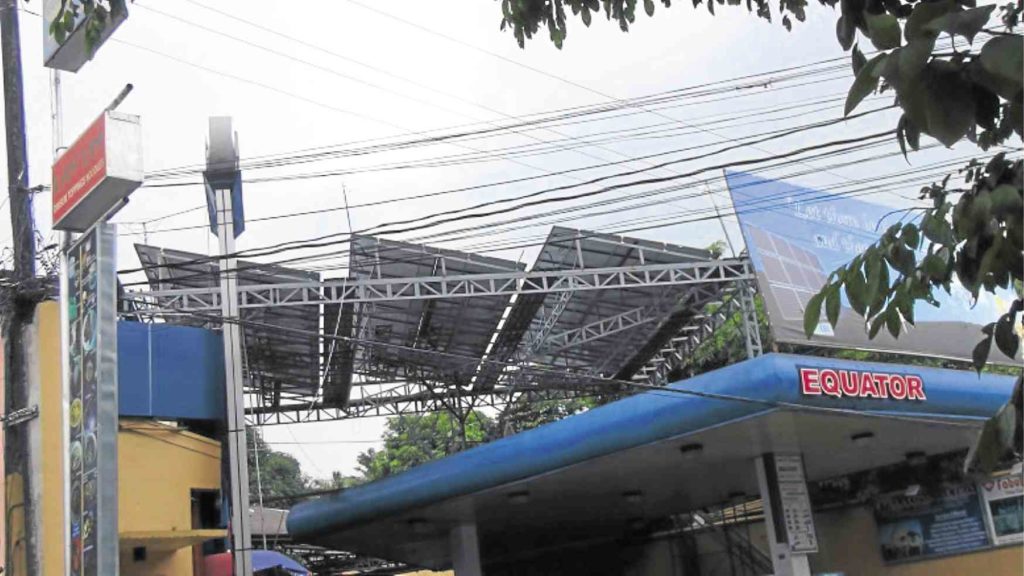
Equator Energy Oil Station is the country’s first and only solar-powered oil station.
Rejection, disbelief and lack of awareness.
These were the issues that local solar energy company Equator Energy Corp. (EEC) had to deal with when it was just starting out—issues which, says EEC founder, president and CEO Bernardo Fabula, became the company’s greatest source of inspiration to continue growing the business.
“It was never easy for [EEC] to catapult its business to success. What makes it survive is a committed and motivated workforce, [coupled with] purpose-driven leadership,” says Fabula, a mechanical engineer, and former member of the Army Corps of Engineers and Society of American Military Engineers. “Another secret is our continuing research and development, [especially with] the advent of new technology in solar resources from various parts of the world. We never stop learning.”
As early as 1996, Fabula says he had already thought of putting up EEC, after learning about the numerous benefits of renewable energy.
His first ventured into the energy sector, however, by putting up in 2001 Equator Energy Oil Station—a business which finally allowed him to pursue his bigger dream of putting up his own renewable energy company to provide Filipinos with a cheaper alternative energy source.
Fabula officially established EEC in 2011, along with his brothers who continue to work with him as members of the company’s board of directors. Equator Energy Oil became EEC’s “laboratory,” after the company installed on it a grid-tied solar power plant. Situated on Bayani Road in Taguig City, Equator Energy Oil is the country’s first and only solar-powered oil station.
Since then, EEC has been involved in the design, supply, installation and maintenance of a variety of alternative energy systems, whether for industrial, commercial or residential use. Aside from solar power systems, EEC also builds wind farms for utilities in rural areas.
“[We do] not only sell or import solar items from abroad, but also design, supply and integrate solar components for the smallest solar kits, solar street lights, solar water and irrigation pumps, [and even for] the biggest hybrid solar systems and industrial-size solar farms,” says Fabula.
He considers one of their creations a major development for the country’s renewable energy sector: The Freenoy Solar Power Machine. Easy to install and use, the Freenoy is ideal for the country’s remotest areas, says Fabula.
“The development of Freenoy, which the company considers the perfect machine, is a milestone in the field of renewable energy. This machine can provide continuous supply of energy using the free fuel from the sun,” he explains. “[It has] no need for fuel and maintenance; can be controlled and monitored remotely without bulky and expensive transmission line from the source; is easy to install and disassemble; can be transported anywhere; can be customized for commercial or residential purposes.”
Equator Energy Corporation president and CEO Bernardo Fabula and his team on their way to the remote municipality of Silvino Lubos in Northern Samar, where a 20-kilowatt Freenoy Solar Power Machine supplies energy for its municipal building.
Freenoy was developed, adds Fabula, specifically to serve Filipinos in remote areas and those affected by natural calamities.
In 2016, EEC deployed one five-kilowatt (kW) Freenoy to Brgy. Marayos, Pinamalayan in Oriental Mindoro, to provide power for those affected by Typhoon “Nina.” Around 35 families had access to basic power needs—for their lights, electric fans, TVs and cellphone charging—for around three months, says Fabula, until electricity was fully restored. Also in Oriental Mindoro is a 5-kw Freenoy on the John Paul College and Montessori School, which is designed to energize the school’s computers, fans, and lights during blackouts that occur twice a day.
The municipality of Silvino Lubos in Northern Samar has also been using a 20-kW version of Freenoy since 2015. It is the main power source of the town’s municipal building.
“The town has no power lines. People take three rides to reach the place—motorcycle, boat, and a four-wheel vehicle,” says Fabula of the remote town. “Freenoy (7 kW) was also installed in Mindanao State University last June 2016, our first solar installation in a government state university in Mindanao. We haven’t received reports, however, if it was damaged during the Marawi battle.”
Aside from the Freenoy, Fabula says solar street lights are another EEC product which they aggressively setting up in the country’s rural areas.
Existing projects include those in Isabel, Leyte; Semirara, Caluya, Antique; Brgy. Das, Toledo City, Cebu; and Lal-lo, Cagayan. Valenzuela City also uses EEC’s 78-kW hybrid solar power system, which Fabula says helps reduce electricity costs in the city and serves as a backup power source during calamities.
He says that unlike the skepticism EEC received when it was still in its birthing stage, more people have now become receptive of solar power systems, especially because of increasing electricity costs.
“A decade ago, people were naive and ignorant about solar [power]. It really took [a huge] effort to convince customers both in government and private sector to adopt solar power as one of their alternative sources of energy. Most of them [had] the wrong notion that solar components are expensive and unreliable. People even refused to accept free demos and solar kits, [believing] it was a waste of time and energy, and very complicated,” says Fabula. “[Now], the company is receiving contracts with government [for] building rooftop hybrid and grid-tied type [solar power systems].”
The company’s gross sales numbers say enough about the quality not just of EEC’s solar products, but of its after-sales service as well: P8 million in 2015, P63 million in 2016, and P200 million last year.
The company’s continued success, plus Filipinos’ wider acceptance of solar power, is enough inspiration for Fabula and his company to expand and continue developing its renewable energy technology. For him, solar power is the key to increasing the country’s energy supply.